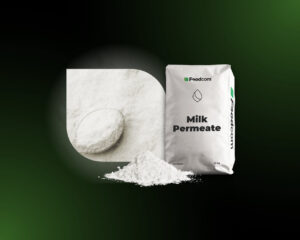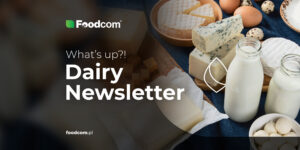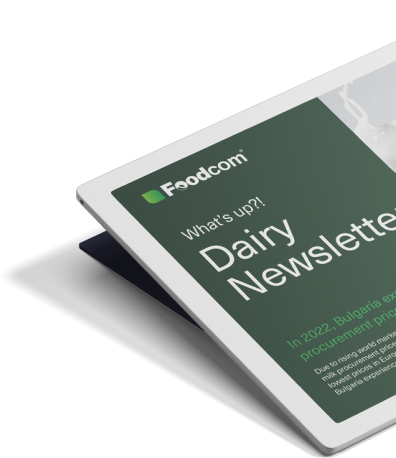- The European dairy market is stabilizing, and price declines have stopped after several months of pressure.
- Prices of fresh butter are rising slightly, supported by a strong cream market, despite the influx of cheaper products from the US.
- British processors Arla and Müller are lowering their milk purchase prices, which is putting further pressure on farmers.
- In the US, dairy herds are growing, which is increasing supply and lowering prices of dairy products.
Welcome Partners!
Welcome back to our newsletter!
The last week of October brought the first clear signs of stabilisation on the European dairy market. After several months of decline, prices have stopped falling and the sales pressure on producers is easing. The impact of lower farmgate prices for milk is also becoming clearer.This factor is limiting the supply of raw material while improving the competitiveness of EU export products.
However, this does not mean that the market has entered a phase of sustained improvement. The fundamentals remain weak. Milk is still plentiful and demand, especially industrial and export demand, is growing very slowly. By the end of the year it is difficult to expect a fundamental change in the trend, while the beginning of 2026 may bring a greater adjustment in supply.
Milk powder
The dairy powder market remains quiet. Skimmed milk powder (SMP) prices remain in the EUR 2 000-2 100/MT range, with a slight improvement in the food segment. Export interest is growing, but still not enough to change the overall trend. Producers remain cautious – the expected restart of public intervention early next year discourages aggressive price cuts.
Whole milk powder (WMP) continues to lose value. Prices are around €3,530/MT. Global markets remain under pressure. In Oceania, WMP prices have fallen below EUR 3 100/MT and in the US SMP remains in the EUR 2 150-2 200/MT range.
Cheese
Cheese prices in Europe have stabilised. After months of declines, the market has entered a more balanced phase. Most producers have reduced selling pressure and buyers are concentrating on replenishing stocks for November and December.
Gouda and mozzarella are trading in the €2,800-2,900/MT range. Sales remain moderate but stable, with older stocks selling out at slightly lower prices.
Cheddar, after falling sharply earlier in the quarter, has stabilised at around €3,400/MT. Buyers are contracting for early 2026 deliveries and producers expect lower supply from Ireland to support prices for the remainder of the year.
Emmental is holding higher at around €4,000/MT, although many market participants doubt that these prices will hold. Production is running at full capacity and stocks are growing faster than demand.
In the short term, cheese prices are likely to remain in a narrow range. Milk remains cheap and readily available, which keeps production costs low, but export demand is still not strong enough to trigger a real rebound.
Fats
Prices for dairy fats remain stable. Butter is trading around €5,200/MT, with a balanced situation between producers and buyers. Retail demand is good, while industrial demand is cautious.
Fresh butter prices have increased slightly, following the strengthening cream market. Traders point to an influx of cheaper fresh butter from the US, which may limit further increases in the coming weeks.
Anhydrous milk fat (AMF) is holding near €6,000/MT, with expectations pointing to stable prices in early November. The market is showing little volatility, supported by seasonal demand and good availability of raw milk.
Liquids
The market for liquid dairy components is showing a mild upward trend.
Cream prices have risen again and are currently in the range of EUR 6 100-6 300/MT, mainly due to seasonal demand from the confectionery and bakery industries. However, the high supply of milk is limiting further price increases.
Concentrate prices have also strengthened slightly. Skimmed milk concentrate (SMC) is selling in the €1,250-1,350/MT range, while liquid whey remains stable at €450-600/MT. Processors are working at full capacity, maintaining a balanced use of raw material.
Raw milk prices remain stable or slightly lower, reflecting ample availability in most regions. Despite seasonal fluctuations, buying levels remain high, which supports production liquidity and keeps pressure on producer margins.
Whey powder
The whey and protein segment remains one of the most dynamic in the dairy industry.
Feed whey prices have risen to EUR 970-980/MT and food whey prices are above EUR 1 050/MT. Growth is supported by strong export demand and limited production in parts of Western Europe.
WPC 80 prices remain exceptionally high at around EUR 12,000/MT, reflecting stable demand in the functional, sports and high-protein food sectors.
WPI (whey protein isolate) is above EUR 20,000/MT and limited availability keeps sellers strong.
Interest also remains in the MPC 70-85(milk protein concentrate) category. Prices are stable, but well above historical averages. Demand is being driven by medical and speciality food manufacturers looking for high-purity, low-lactose ingredients.
The protein market continues to benefit from the structural increase in demand associated with the growing popularity of functional and high-protein foods. Prices are likely to remain high in the coming months, although the increased availability of whey may gradually ease upward pressure in 2026.
What’s new
Europe
More than 10% of Ireland’s dairy herds are affected by lameness, which can cost a farm of 100 cows up to €8,750 a year. Experts recommend that farmers take preventative action before the farrowing season – including regular hoof baths (weekly if infection is present), proper hoof trimming, keeping roads and pens in good condition, providing sufficient space at feedlots and comfortable bedding. By improving these conditions before winter, the risk of lameness during the transition from pasture to concrete floors can be reduced.
Europe
UK dairy farmers are facing increasing financial pressure as Arla Foods and Müller have announced further cuts to the farmgate price of milk ahead of the winter season. Arla will reduce its price to 42.71 pence per litre from 1 November, while Müller will reduce its price to 40 pence from 1 December. The companies explain the decision by an oversupply of milk, a weaker dairy market and lower raw material prices. Farmers’ organisations warn that the cuts will exacerbate liquidity problems at a time when feed and energy costs are rising. The National Farmers’ Union (NFU) is calling on processors to be more transparent with prices and dialogue with producers during the difficult winter months.
North America
In the US, the number of dairy cows is increasing, putting downward pressure on milk and dairy product prices. This situation is a result of previously favourable milk margins and lower feed costs, which have prompted many producers to expand their herds. As a result, milk supply has increased while domestic and export demand has not kept up. Cheese, butter and skimmed milk powder prices have started to fall, benefiting consumers but squeezing producer margins. At the same time, the increasing number of dairy cow slaughterings may help to rebalance the market in 2026.
![Balance returns to the European dairy market [287th Edition Foodcom DAIRY Newsletter] Balance returns to the European dairy market [287th Edition Foodcom DAIRY Newsletter]](https://foodcom.pl/wp-content/uploads/2023/08/Foodcom_Newsletter_Dairy-1520x760.jpg)






